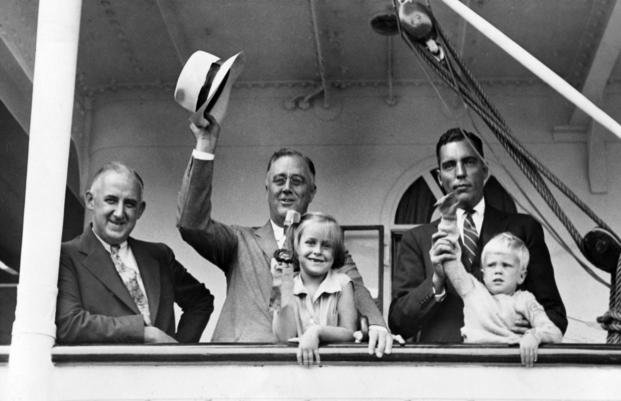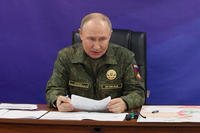William Vincent Astor's life was one of unenviable isolation and singularly strange circumstances. Literally in the manor born, he arrived into the world in the Fifth Avenue mansion of his grandmother, Caroline Astor, who ruled mercilessly over the Knickerbocracy of Manhattan high society. News of his birth in 1891, near the end of the gaudy binge of the Gilded Age, was announced on the front pages of the city’s newspapers, and invariably included estimates of the family’s vast fortune.
However, whatever expectations existed that he would grow into a suave prince of high society were eventually and forever abandoned. Tall and gangly, he would never have been mistaken for handsome. The sickly aspect of his youth never quite left him. Socially awkward among business associates, friends, and in public, he would invariably be defined by the enormous family fortune.
In 1912, his father, recently divorced and more recently married to a woman not much older than Vincent, perished on Titanic, and the majority of the family fortune and vast real estate holdings passed to Vincent. Just 20, he withdrew from his sophomore year at Harvard to manage a portfolio of real estate so extensive as to have earned his family the not altogether flattering sobriquet “New York’s Landlord.” Accumulated over generations of Astors, who bought but rarely sold, the holdings included large swaths of land throughout Manhattan and outer boroughs.
Young Astor, according to most accounts, was a competent though not particularly enthusiastic steward of the real estate empire. Perhaps more than anything, he exhibited signs of civic duty. He supported charities, built a playground and baseball field in Harlem, donated land to the city for public housing, and settled lawsuits not always in the interest of the family fortune. He served on obscure committees, supported well-intentioned reform movements lacking in social cache or fancy charity balls. In one instance, he landed on the executive committee of the America Rumanian-Jewish Emancipation Committee, a very niche organization dedicated to fighting antisemitism in Romania. He founded a home for convalescence of children of the underprivileged not far from his estate in Rhinebeck, New York, which still exists today as Astor Services for Children & Families.
“Is it unreasonable to suppose that because a man is rich, he is also useless?” he once asked. Of course, there was no lack of organizations seeking his financial support, while those that could make use of his natural intellect and enthusiasm were few and far between.
Just when young Astor became intrigued by espionage is unclear. As with many of its practitioners, he seems to have stumbled into it. During WWI he was among dozens of members of the New York Yacht Club who made their yachts available for service, then served as a junior officer on it as a convoy escort. And he seemed to have maintained contact with Office of Naval Intelligence (ONI) during the interwar years, providing morsels of intelligence as they came his way.
In 1930, ONI records noted information Astor transmitted while yachting in the Caribbean and Pacific. However, as was later reported, he was seen as enthusiastic, if a bit naïve about spying. This would not have been an unusual assessment of amateur spies, typically judged dilettantes by the professionals.
Working in the background, Astor was also a founding member of The Room (later known as The Club), a small tightly knit group of powerful, well-connected men who met in secret to share intelligence garnered from New York’s social whirl, travel, and business dealings. Started in 1927, among the club members who met monthly in an unremarkable apartment at 34 East 62 Street were Winthrop W. Aldrich, chairman of Chase National Bank; publishing magnet Nelson Doubleday; diplomat David K.E. Bruce; Marshall Field III, scion of the Chicago department store family and publisher; Allen Dulles, a future Director of Central Intelligence, then a Wall Street lawyer; and William Donovan, a World War I Medal of Honor recipient and future head of America’s first civilian spy organization, the Office of Strategic Services (OSS), at the time working at a Wall Street law firm. Also members of The Room were Kermit and Theodore Roosevelt Jr., two of the former President’s sons.
The Room was largely made up of amateurs, though some of its members did have experience in espionage.
The naturalist and explorer C. Suydam Cutting served in Europe under General John J. Pershing in G-2; William Rhinelander Stewart (the “Best Dressed Man In New York City”), served in ONI; and Sir William Wiseman, a one-time British spy, who settled in the city as an investment banker, is also said to have been a member. Wiseman was perhaps the most skilled and experienced practitioner among the group, having run British intelligence operations in the U.S. during WWI and acting as back channel to President Woodrow Wilson.
An occasional guest would also make an appearance at the Room’s meetings. The famous author and former spy Somerset Maugham, whose book Ashenden (1927) had caused quite the stir by mixing spy fact and fiction, spoke to the members. So did polar explorer Richard E. Byrd. Astor, in fact, was the primary backer of Byrd’s 1929 aeronautical expedition to Antarctica, subsequently getting a mountain there named after him.
These were very much men of a larger world at a time when travel was beyond the means of most. Jetsetters before there were jets, they traveled on the grand ocean liners and private yachts to the capitals of Europe, South America, and beyond, bringing back political insights, gossip, business rumors, and economic news. They were also dedicated private clubmen. No doubt, members of some of New York’s most exclusive clubs shared news and opinions, unaware their tales would be discussed in an even more exclusive club.
Relevant items were discreetly passed on to officials in the State Department, the Office of Naval Intelligence (ONI) or other agencies. However, with the election of Franklin D. Roosevelt to the presidency in 1933, the Room’s activities picked up considerably.
Cryptic Cabinet
Roosevelt, of course, welcomed the bits and pieces members of The Room passed along. The president’s fondness for intelligence—confidential sources—was well known, even extending to fiction. When Kermit Roosevelt, Theodore Roosevelt’s oldest son, needed a gift for the president, he chose a book from the Clubfoot espionage series by Valentine Williams. It’s notable that Williams, as a real-life British spy, earned a place in espionage history for a brief encounter with British traitor Harold “Kim” Philby, also a fan of the Clubfoot series. He gets a call out in Philby’s memoir, My Silent War, in which the two share a Rolls Royce car ride into London.
The amateur spies of The Room were still amateurs, receiving no payment for their efforts or official directives to guide them. This was by design. The fact they were not connected to any official intelligence organization provided cover for the president in the event their activities were detected. America, after all, was still officially neutral in the conflict.
The make-up of The Room’s members would have also appealed to the president. While assistant secretary of the Navy, he dabbled in intelligence by way of the ONI, slotting in friends from Harvard and members of the upper crust among the ranks of volunteers. Just as with those early ONI recruits, virtually all the members of The Room were personally known to FDR through boarding schools, college, or elite social circles. Some, like Astor, could lay claim to connections in England, either through blood, schooling, or business.
Needless to say, neither Roosevelt’s ONI nor The Room were egalitarian enterprises. Most members had been born into their place of privilege. They were very much men of their time and social standing, possessing all the foibles, follies, and unquestioned certainties considered unseemly today. However, their place as “gentlemen” bestowed on them the trust and easy access required to act as effective spies.
Gentlemen spies were not new. Men of considerable means and wide-ranging trusted contacts had long been involved in espionage,both in formal and informal ways. Even early British espionage thrillers, such as The Riddle of the Sands: A Record of Secret Service (1903), by Erskine Childers, featured a pair of U.K. yachtsmen as amateur spies foiling a dastardly German plot.
With so many of the Room’s members captains of industry, the acquisition of intelligence was not difficult. In one instance, Aldrich, in his position at Chase National, accessed information on suspicious funds flowing through foreign bank accounts like Japan and the Soviet Union. “Espionage and sabotage need money, and that has to pass through the banks at one stage or another,” Astor wrote the President.
Indeed, in the case of AMTORG, the Soviet trade organization, questionable expenditures at one point totaled an estimated $2 million a week, at least some of which was said to be used for espionage. This bit of intelligence was particularly prescient as AMTORG would prove a persistent spy nest for decades.
In another instance, Astor, as director of Western Union Cable Company, passed along bits of correspondence from foreign operatives and officials sent through the company’s lines. He is also reported to have terminated an agreement that would have provided a more efficient means of communication for Axis powers, according to ONI historian Jeffrey M. Dorwart.
However, even more noteworthy, Astor maintained close contact with James Paget and his deputy, Walter Bell, of Great Britain’s Passport Control Office, which served as a front for British spy operations. It was Astor who acted as a reliable back channel between British intelligence and FDR.
That the British cooperation was “unofficial” was understood from the start, at least as far as Astor was concerned.
Back Channel
“Shortly after the ‘club’’s {sic] formation, it occurred to me that Paget and Bell might from time to time obtain leads useful to us,” he wrote to FDR. “I therefore arranged a meeting with Paget, at which I asked for unofficial British cooperation, but made it clear that we, for obvious reasons, could not return the compliment in the sense of turning over to them any of our confidential information.”
He added, “This somewhat one-sided arrangement was gladly accepted, This was natural, inasmuch as any success that we might have in discouraging sabotage, etc., would be to his advantage.”
Not stated, though clearly to British advantage, was not only the proverbial foot in the White House door, but a trusted conduit to the president that bypassed the State Department or FBI.
True to its word, British intelligence did provide Astor access to secrets. In perhaps the most significant instance of sharing, they allowed him to rummage through diplomatic pouches intercepted in the British Crown colonies of Trinidad and Bermuda. The intelligence garnered from these intercepts proved a treasure trove of intelligence for the president.
“In regard to the opening of diplomatic pouches in Bermuda and Trinidad, I have given my word never to tell anyone—with always you excepted,” Astor wrote FDR.
“The fear of the British is that if the facts became known, the writers would exercise great caution or send their letters via a different route.” It is possible, if not likely, this mail-opening operation was conducted at Ferry Reach, Astor’s Bermuda estate.
New SpyTalk contributor Henry R. Schlesinger is an author and journalist who has been writing about things espionage for more than two decades. His most recent book is Honey Trapped: Sex, Betrayal, and Weaponized Love.
This article first appeared on Spytalk.co.












